Hyundai Tucson: Front and Rear Washer Motor
Inspection
- With the washer motor connected to the reservoir tank, fill the reservoir tank with water.
- Before filling the reservoir tank with water, check the filter for foreign material or contamination, if necessary, clean the filter.
- Connect positive (-) battery cables to terminal 1 and negative (+) batteiy cables to terminal 2 respectively.
- Check that the motor operates normally and the washer motor rans and water sprays from the front nozzles.
If they are abnormal, replace the washer motor.


Washer Fluid Level Sensor
- Disconnect the negative(-) battery terminal.
- Drain the washer fluid less than 400 cc.
- Check for continuity between the No. 1 and No.2 terminal in each float
position.
If the continuity is not as specified, replace the washer fluid level sensor
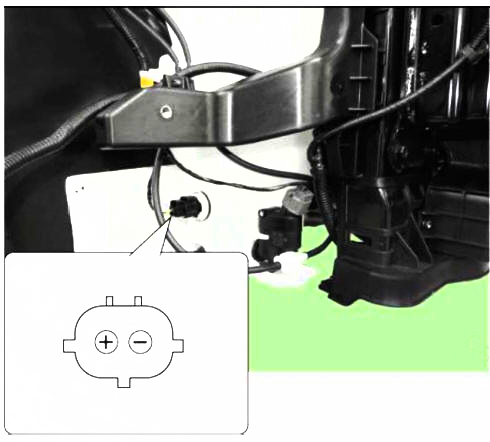
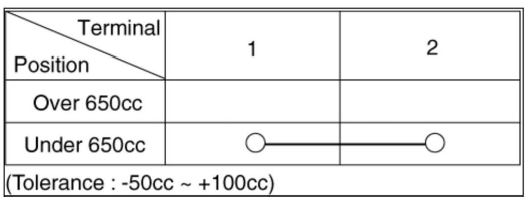
Removal
- Disconnect the negative (-) battery terminal.
- Remove the right front wheel guard.
(Refer to Body - "Front Wheel Guard" )
- Remove the washer hose and disconnect the washer motor connector.

- Remove the washer motor.
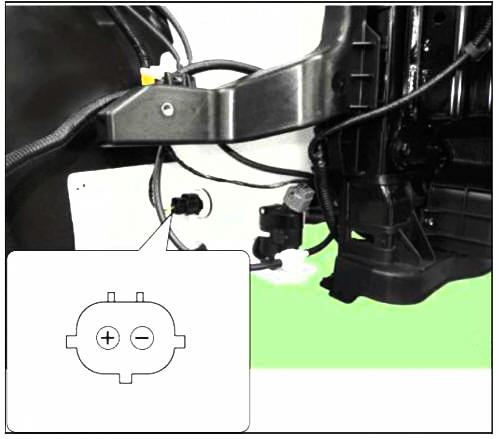
- Remove the washer reservoir (A) after loosening mounting bolts.

Installation
- Check the filter for foreign material or contamination.
- Install the washer reservoir.
- Install the washer motor.
- Connect the washer motor connector and washer hose.
- Install the front wheel guard.
Integrated Rain Sensor
Description
Integrated rain sensor (A) controls three systems: front wiper, auto-light, and central air conditioner.
- Wiper Control System
When "AUTO" switch signal is received from the multi-function switch on the right, the integrated rain sensor detects the amount of rainfall. The sensor is installed inside the upper part of the front window for wiper motor control.
This system automatically controls the operation duration and speed of the wiper depending on the measured amount of rainfall even if the driver does not operate the wiper switch.
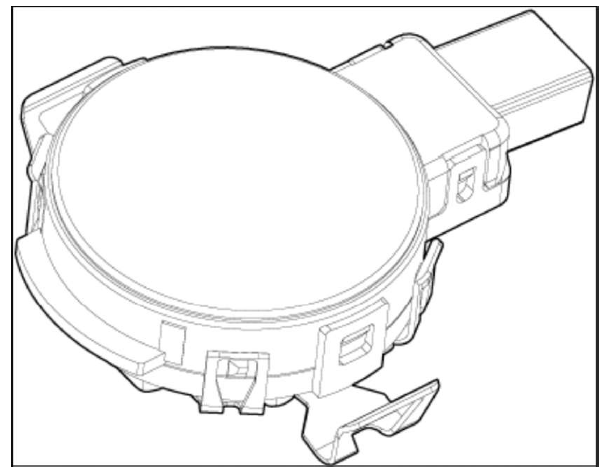
Functions and Operating Principles
Basic Principle
- Detecting the amount of rainfall
The light (beam) emitted from light emitting diodes (LED) is totally reflected on the external surface of the windshield and comes back to the photo diodes. When there is water on the external surface of the windshield, the light is optically separated and reflected partially and the remaining brightness is measured by the photo diodes. Water remaining on the windshield results in the light being not totally reflected. The loss of brightness due to this indicates how much the glass surface is wet.
Interference
Rain sensor might malfunction due to the interferences listed below.
- Dust on the measuring surface and other surfaces on the light path (surface of light emitting diodes and photo diodes, fiber optics, bracket, and glass surface of windshield joint area) weakens the received light.
- Movement of windshield and bracket
- Movement of bracket due to vibration
- Damaged wiper blade
When the integrated rain sensor does not operate or malfunctions, the driver should operate the wiper switch manually.
Automatic Operation
- Operational status of rain sensor
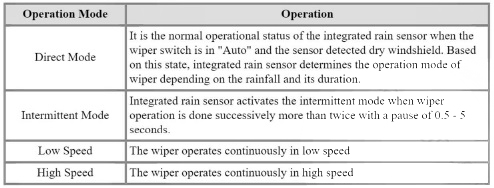
Safety Function
- When there is ice or foreign matter in the detecting area, integrated rain sensor cannot recognize the condition for operation correctly.
Detecting Special Conditions
- Rain sensor
Special Condition/ Operation based on special conditions detecting
Splash/ When integrated rain sensor detects a high level of water (splash) in Direct or Intermittent mode, the system switches from Park to High speed. Then, wiping is done once in High speed and once more in Low speed. If the condition of rainfall does not change after wiping, it returns to the original condition (Direct or Intermittent).
Smearing/ Smearing is a thin oil film that has dried fast and occurs when a small amount of rainfall is wiped by a dirty or worn-out wiper blade.
Operational signal should not be issued when smearing occurs in Direct or Intermittent mode.
Dirt/ When no change is detected after wiping, integrated rain sensor determines that the windshield is dirty. In this state, operational signal should not be issued. If the windshield becomes clean (for example, by washer fluid), the integrated rain sensor returns to the normal condition.
Washer fluid/ Integrated rain sensor does not respond to the washer fluid during the Washer mode. In other words, wiping speed does not change even if the washer fluid is sprayed (automatic operation of the washer pump is not reflected in the functioning of integrated rain sensor).
Removal
- Do not damage or touch the silicone (coupling medium).
- Be careful so that the silicon is not contaminated by foreign substances, dust, etc..
- Use caution, as the silicon may be damaged if you try7 to separate the rain sensor forcibly.
- The dust or foreign substance on the rain sensor may have bad influence on the performance of the rain sensor. In order to ensure accurate function of the rain sensor, protect the sensor surface with the protection cover until the sensor is installed on the bracket
- The coupling pad on the ram sensor surface is adhesive and the coupling pad may stick to the windshield during the use depending on the environment condition.Therefore, it may be damaged when you try to remove the ram sensor from the windshield forcibly. Use caution when sepearting it from the windshield.
- Remove the multi sensor cover (A)&(B).

- Disconnect the wiring harness connector from the rain sensor by inserting a small flat-blade screwdriver (A) into the space.

- Using a flat-blade screwdriver (-), remove the rain sensor bracket.

- Remove the ram sensor.
1)Insert a small flat-blade screwdriver (-) into a space at the bottom(B) or top(A), between the rain sensor and bracket..
2)The ram sensor slowly up and down in the vertical direction of the glass, then disassemble the rain sensor slowly from windshield without damaging the silicone on the sensor.
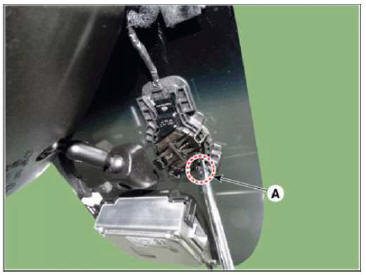
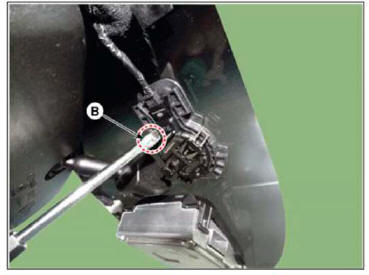
- It may be damaged when you try7 to remove the rain sensor from the windshield forcibly. Use caution w7hen sepearting it from the windshield.
- When detaching the silicone under a high temperature, it may be easily damaged because of the adhesive strength of the silicone. Remove the silicone in a cool enviroment.
READ NEXT:
 Windshield Wiper Washer - Installation
Windshield Wiper Washer - Installation
Check the operation of the rain sensor and the light sensor before
mounting.
Check the sensor for silicon damage.
Check w7hether the rain sensor connector is tightened.
Check w7hether the rain sensor and bracket are properly tightened.
 Rear Wiper Washer - Removal
Rear Wiper Washer - Removal
Disconnect the negative (-) battery terminal.
Loosen the mounting nut and remove the rear wiper arm & blade (A).
WARNING
Take care not to damage the rear glass when removing the rear wiper
arms & blades.
Remove the tail gat
SEE MORE:
 TP Read Protocol
TP Read Protocol
Description
The immobilizer system will disable the vehicle unless the proper ignition
key is used, in addition to the currently available antitheft
systems such as car alarms, the immobilizer system aims to drastically reduce
the rate of auto
 SRS care
SRS care
The SRS is virtually maintenance-free
and there are no parts you can safely
service by yourself. If the SRS air bag
warning light does not illuminate when
the Engine Start/Stop button is in the
ON position, or continuously remains
on, we recomm
Information
- Home
- Hyundai Tucson - Fourth generation (NX4) - (2020-2023) - Owner's Manual
- Hyundai Tucson - Fourth generation (NX4) - (2020-2023) - Workshop Manual